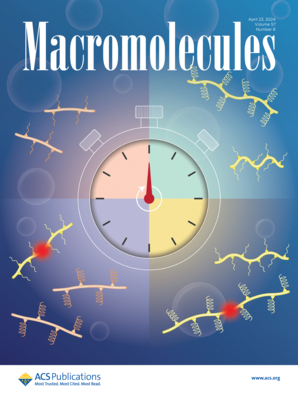Clustering and Nanoscale Vitrimeric Behavior in Telechelic Polybutadiene Model Vitrimers
IF 5.1
1区 化学
Q1 POLYMER SCIENCE
引用次数: 0
Abstract
Despite the promise of vitrimeric materials applications, there are many aspects that remain poorly understood. To advance the fundamental knowledge of these materials, model systems of well-controlled composition are needed. Here we report the synthesis of polybutadiene-based model vitrimers, which are further investigated with respect to their structure and dynamic properties. Four vitrimers with different cross-linking concentrations were obtained by modifying the molecular weight of the precursor functionalized polybutadiene precursors. A tetrafunctional aromatic cross-linker was used in all cases. Due to the nature of the cross-linker, the resulting vitrimers exhibit fluorescence indicative of cross-linker association. The structural investigation by small-angle X-ray diffraction showed that the cross-linkers cluster together to form very stable cylindrical structures linked by polybutadiene chains. The dynamic behavior of the vitrimers, as studied by differential scanning calorimetry and broadband dielectric spectroscopy, can be interpreted by the presence of such a cluster structure, where already a few degrees above the glass transition there are significant fluctuations of the dynamic covalent bonds, which remain essentially limited to the intracluster level─i.e., confined in the interphase between the cross-linkers’ clusters and the polymer. This results in rubber-like vitrimeric materials in which the mechanical stability is maintained by the cluster network as long as it is not perturbed by the application of high mechanical stresses, in stark contrast to recently investigated polyisoprene-based model vitrimers with flexible triamine cross-linkers, which also exhibit cluster structure.

求助全文
约1分钟内获得全文
求助全文
来源期刊

Macromolecules
工程技术-高分子科学
CiteScore
9.30
自引率
16.40%
发文量
942
审稿时长
2 months
期刊介绍:
Macromolecules publishes original, fundamental, and impactful research on all aspects of polymer science. Topics of interest include synthesis (e.g., controlled polymerizations, polymerization catalysis, post polymerization modification, new monomer structures and polymer architectures, and polymerization mechanisms/kinetics analysis); phase behavior, thermodynamics, dynamic, and ordering/disordering phenomena (e.g., self-assembly, gelation, crystallization, solution/melt/solid-state characteristics); structure and properties (e.g., mechanical and rheological properties, surface/interfacial characteristics, electronic and transport properties); new state of the art characterization (e.g., spectroscopy, scattering, microscopy, rheology), simulation (e.g., Monte Carlo, molecular dynamics, multi-scale/coarse-grained modeling), and theoretical methods. Renewable/sustainable polymers, polymer networks, responsive polymers, electro-, magneto- and opto-active macromolecules, inorganic polymers, charge-transporting polymers (ion-containing, semiconducting, and conducting), nanostructured polymers, and polymer composites are also of interest. Typical papers published in Macromolecules showcase important and innovative concepts, experimental methods/observations, and theoretical/computational approaches that demonstrate a fundamental advance in the understanding of polymers.
 求助内容:
求助内容: 应助结果提醒方式:
应助结果提醒方式:


